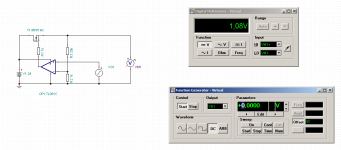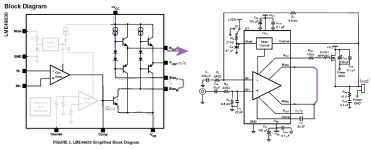Hello,
I want to build a Mos-Fet (single-ended / high-voltage / medium-power) amplifier with the Texas Instruments LME49830 driver : in my application, I just have to cope with positive input signals so I only need one N-Channel Mos-Fet for the output stage.
Could someone (with solid know-how) indicate me the way I should connect the unused negative output section of the LME49830 driver for this application ?
Thanks
I want to build a Mos-Fet (single-ended / high-voltage / medium-power) amplifier with the Texas Instruments LME49830 driver : in my application, I just have to cope with positive input signals so I only need one N-Channel Mos-Fet for the output stage.
Could someone (with solid know-how) indicate me the way I should connect the unused negative output section of the LME49830 driver for this application ?
Thanks
Hello palstanturhin,
Yes indeed with solid know-how !
Concerning the page 6 of the datasheet please try to read it again as it's just a test circuit for the driver alone without any power output stage !
Same advice for my initial question : read it again and if you can't understand forget it.
Thanks.
Yes indeed with solid know-how !
Concerning the page 6 of the datasheet please try to read it again as it's just a test circuit for the driver alone without any power output stage !
Same advice for my initial question : read it again and if you can't understand forget it.
Thanks.
palstanturhin,
In my application, I need to drive only the N-Channel power Mosfet as the output stage : how can I short the bias pins of the LME49830 and polarize this Single-Ended output stage at the same time ?!
Again I have to amplify only positive signals so I don't need Push-Pull output stage but a Single-Ended one to make a high-voltage/medium power amplifier.
Thanks.
In my application, I need to drive only the N-Channel power Mosfet as the output stage : how can I short the bias pins of the LME49830 and polarize this Single-Ended output stage at the same time ?!
Again I have to amplify only positive signals so I don't need Push-Pull output stage but a Single-Ended one to make a high-voltage/medium power amplifier.
Thanks.
palstanturhin,
In my application, I need to drive only the N-Channel power Mosfet as the output stage : how can I short the bias pins of the LME49830 and polarize this Single-Ended output stage at the same time ?!
Again I have to amplify only positive signals so I don't need Push-Pull output stage but a Single-Ended one to make a high-voltage/medium power amplifier.
Thanks.
You can not cross zero (ground) in this type of application and LME49830 as the driver, so that means your mosfet is in its conductive mode all the time. There is nothing you can bias. (however, you could also make a CCS to the output or something...)
So, if you want to be able to get zero output from your circuit, you need the negative rail, or you must choose an other driver for the output. But if you are fine with the output being anywhere between the ground and the positive rail all the time, then LME49830 is just fine.
You could take the feedback from the FETs source resistor for example. If you want voltage feedback; choose BJT for the output. The output circuit depends completely on what exactly you want to control with your amplifier and how...???
A basic sketch of your application could be helpful.
Monas suggestion of a PSU kind of system is one way to go. Look for opamp controlled PSUs...
Draw a sketch.
Dear palstanturhin,
Keep in mind that my application is not dedicated to audio so I don't need to offset the output when the input voltage is equal to 0 volt.
I already know that making an Op-Amp controlled PSU could be a solution but I need to cope with much higher voltages than 24V and as I also need a high power bandwidth, I choosed the LME as a driver ! After all, it's also an Op-Amp stable with capacitive loads and able to drive several power Mosfets in parallel, isn't it ?
Please read again my initial message where I mention the high-voltage criteria.
YES I am fine with the output being anywhere between the ground and the positive voltage supply rail all the time because the input signal is ALWAYS positive as I've already indicated it : so I know that the LME driver is a good choice and I also know how to connect the negative feedback but nobody can confirm how to connect its bias pins and outputs properly ! Perhaps that I just have to leave the unused P-Channel output pin "Pout" non connected...but I'm not sure.
Just imagine a power amplifier with only N-Channel Mosfets as the output stage and the output voltage swinging between 0V and the positive supply rail (less than 100V).
Keep in mind that my application is not dedicated to audio so I don't need to offset the output when the input voltage is equal to 0 volt.
I already know that making an Op-Amp controlled PSU could be a solution but I need to cope with much higher voltages than 24V and as I also need a high power bandwidth, I choosed the LME as a driver ! After all, it's also an Op-Amp stable with capacitive loads and able to drive several power Mosfets in parallel, isn't it ?
Please read again my initial message where I mention the high-voltage criteria.
YES I am fine with the output being anywhere between the ground and the positive voltage supply rail all the time because the input signal is ALWAYS positive as I've already indicated it : so I know that the LME driver is a good choice and I also know how to connect the negative feedback but nobody can confirm how to connect its bias pins and outputs properly ! Perhaps that I just have to leave the unused P-Channel output pin "Pout" non connected...but I'm not sure.
Just imagine a power amplifier with only N-Channel Mosfets as the output stage and the output voltage swinging between 0V and the positive supply rail (less than 100V).
Hi tauro0221,
Thank you for your advice : the LTC6090 is indeed very interesting for high-voltage applications as the supply mode can be split (+/-70V) or even unipolar (140V) but I'm afraid about its ability to drive high capacitive loads such as power Mosfets at high frequencies in a stable manner : LT indicates 200pF as a limit and less than 40KHz for the full power bandwidth. Concerning the output capacitive load ability, it might not be a real problem to cope with as I think that it only concerns the capacitive value between the circuit's output and the ground but the full power bandwidth is too low : I at least need 80KHz as the LME49830 can handle.
Thank you for your advice : the LTC6090 is indeed very interesting for high-voltage applications as the supply mode can be split (+/-70V) or even unipolar (140V) but I'm afraid about its ability to drive high capacitive loads such as power Mosfets at high frequencies in a stable manner : LT indicates 200pF as a limit and less than 40KHz for the full power bandwidth. Concerning the output capacitive load ability, it might not be a real problem to cope with as I think that it only concerns the capacitive value between the circuit's output and the ground but the full power bandwidth is too low : I at least need 80KHz as the LME49830 can handle.
> Yes indeed with solid know-how !
You are using a specific-application chip in a way not shown in the notes, and probably never contemplated by the original designer or any later user. It is very possible that NOBODY has "solid know-how" in your intended use.
It does not help it was designed at National, who were bought-out by TI, but (at least tonight) TI's site can't find the '49830 base document.
It sure would help to know what you are doing. Electrophoresis? Power supply? Spark-coil drive? CRT-cathode video driver? Curve plotter?? Each of these offers different ways it could go wrong.
Not at all clear why you can not just drop on a dummy P-chan FET just to be sure.
Here is the base spec-sheet.
https://www.digchip.com/datasheets/parts/datasheet/321/LME49830-pdf.php
Looking at the guts (attached), it is clear you need to connect the Bias terminals to get the Vas stage (Qvas and current source load) to work. If you do not need to bias for cross-over, it appears they may be shorted. (There is a jump-point on one of the evaluations to do this.)
Then the output stage may be just the N-type half.
BUT.... this chip WILL easily drive the Gate negative to the minus supply rail. If the load(?) returns to ground, and rail is over -20V, the gate insulation will be punctured! (A complement P-type would limit this reverse voltage.)
It is not real clear to me what to do with Mute in your application. Or the Protection/Osense pin. Also unclear if you need input and NFB caps. I will assume you know some of this, and will figure the rest on breadboard.
I also note that "Buy LME49830 here!!" ads from Major Distributors are not popping up in Google, as they do for most in-stock chips. eBay has a selection, good prices, but I'd be wary of fakes. Especially using it off-spec, you may not know if it is your implementation or a crap chip.
You are using a specific-application chip in a way not shown in the notes, and probably never contemplated by the original designer or any later user. It is very possible that NOBODY has "solid know-how" in your intended use.
It does not help it was designed at National, who were bought-out by TI, but (at least tonight) TI's site can't find the '49830 base document.
It sure would help to know what you are doing. Electrophoresis? Power supply? Spark-coil drive? CRT-cathode video driver? Curve plotter?? Each of these offers different ways it could go wrong.
Not at all clear why you can not just drop on a dummy P-chan FET just to be sure.
Here is the base spec-sheet.
https://www.digchip.com/datasheets/parts/datasheet/321/LME49830-pdf.php
Looking at the guts (attached), it is clear you need to connect the Bias terminals to get the Vas stage (Qvas and current source load) to work. If you do not need to bias for cross-over, it appears they may be shorted. (There is a jump-point on one of the evaluations to do this.)
Then the output stage may be just the N-type half.
BUT.... this chip WILL easily drive the Gate negative to the minus supply rail. If the load(?) returns to ground, and rail is over -20V, the gate insulation will be punctured! (A complement P-type would limit this reverse voltage.)
It is not real clear to me what to do with Mute in your application. Or the Protection/Osense pin. Also unclear if you need input and NFB caps. I will assume you know some of this, and will figure the rest on breadboard.
I also note that "Buy LME49830 here!!" ads from Major Distributors are not popping up in Google, as they do for most in-stock chips. eBay has a selection, good prices, but I'd be wary of fakes. Especially using it off-spec, you may not know if it is your implementation or a crap chip.
Attachments
- Status
- This old topic is closed. If you want to reopen this topic, contact a moderator using the "Report Post" button.
- Home
- Amplifiers
- Solid State
- LME49830


